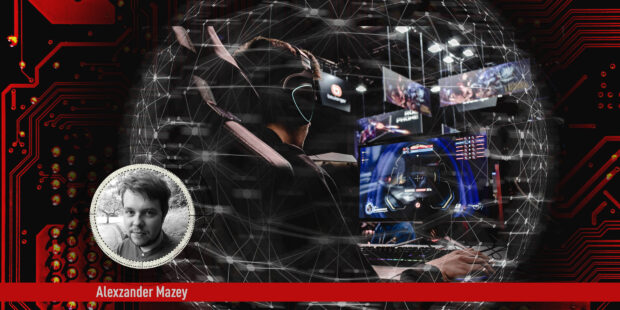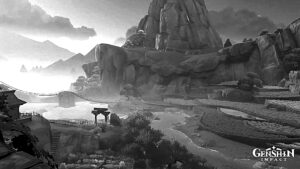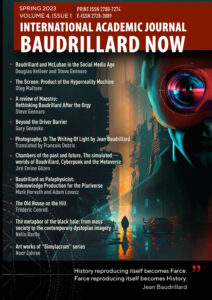
by Alexzander Mazey
‘We lived once in a world where the realm of the imaginary was governed by the mirror, by dividing one into two, by theatre, by otherness and alienation. Today that realm is the realm of the screen, of interfaces and duplication, of contiguity and networks. All our machines are screens, and the interactivity of humans has been replaced by the interactivity of screens. Nothing inscribed on these screens is ever intended to be deciphered in any depth: rather, it is supposed to be explored instantaneously, in an abreaction immediate to meaning, a short-circuiting of the poles of representation.’ – Jean Baudrillard, Xerox and Infinity
When once video games represented a virtual plane without consequence, today they inform an entire social structure where, like the shopping malls before them, the future is realised, ‘the sublimate of all real life, of all objective social life, in which not only work and money disappear, but also the seasons, those distant vestiges of a cycle which has at last also been homogenized!’ (The Consumer Society, Jean Baudrillard.)
Where gaming screens once sat in complete communication as social nodes found in the visual communication of the arcade, with its neon lights and artificial standing, presently, still concerned and embedded within those things exterior to the virtual, arcades collect the same dust bunnies as we do. Nonetheless, the arcade has gone inside and intimate and as inescapable as the shopping mall fired off into the virtual, and yet lowering down its tendrils from above in the form of internet optics and the foggy haze of wi-fi mists; all the promises of interconnectivity realised by the world of video games.
‘In the face of extreme reality we are defenceless. But this is only a beginning. We are the aborigines, the anthropoids of the virtual.’ Writes Jean Baudrillard in Cool Memories V: 2000 – 2004. It is today platitudinal to mention how such games come to us as precursors of this virtual ontology where we exist, contemporarily speaking, as anthropoids. It was once said ‘chased from the real by the violence of history’, myth finds refuge in cinema; but today myth resides in the virtual also, where the spectator’s participation within the mythology is realised through a profound coexistence. It is no longer enough to pronounce the anthropological standpoint on screened ecstasy as a pastime for entertainment’s sake alone. Something else appears.
Life today occupies the earliest signs of vaporous liminality; the threshold between the social and the virtual, where, in words taken from The Consumer Society, ‘[w]ork, leisure, nature and culture: all these things which were once dispersed, which once generated anxiety and complexity in real life, in our ‘anarchic and archaic towns and cities’, all these sundered activities, these activities which were more or less irreducible one to another, are now at last mixed and blended, climatized and homogenized in the same sweeping vista of perpetual shopping.’
Video games mimic the signs of perpetual shopping, of loot boxes, downloads without end, gacha and sign-values transposed onto elsewhere worlds, all wound-up by the promiscuity of click-bait advertisement. In the industry of video game entertainment, there is always an orgasm waiting to happen. The virtual plane which finds itself embedded in cultural output is today made increasingly successful by epidemics and disasters, (which are themselves often virtual), and yet the most commercially achieved products still remain disconnected from any ‘already dead and rotting’ referentialism, holding no illusory allegiance in geopolitical terms, revelling in the vestiges, the fading landscapes of old-world capital.
Yes, the complexity of life is eviscerated in video games. This is no better realised than in the clouded-fantasy world of ‘Teyvat’, which offers neither high fantasy nor intrusion, replacing the complexity with a cold mythology from which we provide the heat. It is unsurprising how Genshin Impact, the video game developed and published by the Chinese game developer and animation studio, miHoYo, has found recent controversy precisely in the way it provides ontological subsidence. Here, cultural dissension defers the seriousness of our reality.
As propagandists turn their gaze away from Russia and Iran and onto China, stoking the geopolitical sensitivities that exist there, we have today seen increasing racial hatred against Asian people, exacerbated by certain Covid-19 narratives. Diverting attention from these issues, we have recently observed a failed attempt by social media to boycott miHoYo’s Genshin Impact. Despite the otherwise positive reception of this video game, these advocates of what we might call the contemporary manifestations of cancel culture have used moral sanctimony and its indistinguishable performativity to promote racist stereotypes regarding the backwardness of the cultural production that occurs outside of the Americanised landscape. Clinging onto the lost referentials of empire, virtue performativity (un)wittingly continues the job of American capitalism and the imperialist narratives that accompany it.
Capturing a glimpse of the corpse in the mirror perhaps Genshin Impact cuts too close to the bone, especially for those players who play – and pursue playing – only to feel something in their objection towards it. This is the irony of our culture today, not participation without enjoyment, but instead the desire to find the absence of enjoyment within participation, which in turn finds its own thinly veiled pleasure.
The virtual represents the emergence of a strong culture; and as Baudrillard writes in America, ‘strong cultures […] reflect back to us the image of our degraded one, and the image of our profound guilt.’ As one sinks time into a virtual plane, we know, as all gamers know, it is best not to feel guilty, to not even entertain guilt as a value worth pursuing, not anymore. Nonetheless, the reflected image becomes as our own degraded reality, we know this: the fantasyland of Genshin Impact – existing within this virtual elsewhere known as ‘Teyvat’, after all – is a world made up of simulacra. The xeroxed cultures of a Chinese-themed metropolis, ‘Liyue’ and its European counterpart found in the ‘Free City’ of ‘Mondstadt’, provide familiar hyper-medieval-fantasy textures that are nonetheless rendered through both residue and absence. Some geographies are best understood through the aesthetics of their disappearance. ‘Mondstadt’ is picked clean of anything other than the necessary aesthetic outlay of cathedrals and windmills, whilst ‘Liyue’ exists as a wide expanse of windswept pagodas. There is nothing immoral here; the game only comes to represent as a development within Baudrillardian transaesthetics, or perhaps no development at all.

Figure 1. A View from Qingce Village, 2021. This quiet village sits in the shade of Wuwang Hill.
(Genshin Impact, miHoYo).
In the essay on Transaesthetics, taken from The Transparency of Evil, Baudrillard provides the following:
‘By its liberation of form, line, colour, and aesthetic notions – as by its mixing up of all cultures, all styles – our society has given rise to a general aestheticization: all forms of culture – not excluding anti-cultural ones – are promoted and all models of representation and anti-representation are taken on board. Whereas art was once essentially a utopia – that is to say, ultimately unrealizable – today this utopia has been realized: thanks to the media, computer science and video technology, everyone is now potentially a creator.’
Caught within the inescapable mise en scène of this virtual plane society, we might push Baudrillard’s analysis beyond ‘potential creator’ to encompass ourselves as mandatory participants. Recall the totalising nature of participation within contemporary society, of feeling included, of being inclusive – which is to say inclusivity – caught between never quite sure if you even wanted to be here in the first instance, and never quite sure if an outside existed, anyway. Nonetheless, pushing these virtual and technologically achieved geographies to the edges of the map, as with empire and the conquests of imperialism before it, inclusivity becomes as a supreme being, it is the inclusivity of an entire ontological position with no outside. Rejoice. You will be included. What better thing than to have God notice you.
And like all societies, ‘Teyvat’ remains governed by an assortment of these seductive Gods. Within the game’s lore, these Gods are known in Genshin Impact as ‘Archons’, an attractive bunch who rule with two parts apathy and one part benevolence. Playable archons, like the tone-deaf bard ‘Venti’ exist inside mortal vessels whilst summoning their power through elemental mastery. Only in this virtual utopia, the satellite utopia of planet earth, could Gods be made flesh. Through an ironic fate, it would be a Chinese video game developer which trumped the ‘brilliant superstructure’ of New York City in terms of hyperreality, since ‘Teyvat’ embodies a world not where travellers find ‘‘Every special effect’, to quote Baudrillard’s America, but where they find a virtual plane whose ‘superstructure’ is only effect. This is the astrality of virtual worlds not only ‘bathed in artificial light’ but existing as the artifice themselves, a closed circuit of artificial feedback where nothing genuine escapes, as with Teyvat’s tale of two cities, ‘Mondstadt’ and ‘Liyue’, for example, fulfilling ‘all the special effects of mixing races and empires.’
Perhaps Baudrillard was wrong to limit the cities of the future to the (horizon)tal where cities will instead come to exist virtually; aestheticized beyond even the signs of violence, and the violence of history. None of this is to suggest ‘Teyvat’ today exists as a replacement for the city in contemporary terms, but as a blueprint for the cities of tomorrow, where colour and time are eviscerated beyond the point of even a nostalgia for the terrestrial referential of the seasons. Seasons do not exist on the virtual plane; it is perpetual sunlight where weather is realised as a transaesthetic accompaniment. When such a feature as the seasons appears in video games, it is only to draw attention to the difference of colour and texture, to mimic the passing of time in a world without it.
Here, there is no consequences to weather; no floods or virtual disasters, walking out to Teyvat’s ‘Stormbearer Mountains’ one may stand and watch the lightening fall with all the strength and grandeur of its sign which is nonetheless artificial. It is the spectacle of weather, a visual performance where every true quality of rain disappears as if evaporated before landing upon the sands of the desert, which is itself green; greener than green. miHoYo, intuiting the esoterism of the hyperreal – as with all successful video game developers – have themselves developed as the high priests of artifice. ‘There is nothing immoral here.’ To repeat Baudrillard’s words, taken from The Transparency of Evil, referring here again to the transaesthetics which proliferate themselves ‘beyond good and evil’ – it is perhaps even wrong to call this trickery. To perceive video games as a dishonest representation of our society and its culture is to ignore the ontological conditions built by way of mythology and fiction.
Observing ‘Stormbearer Mountains’, caught after the calm of the storm, caught within the moment of another totalising tranquillity, one cannot help but realise how ‘we manufacture a profusion of images in which there is nothing to see.’ As with the blue firmament above, or the more green-than-green grass, which rolls horizontally as the hills hint towards themselves, these ‘present-day images – be they video images, paintings, products of the plastic arts, or audiovisual or synthesized images – are literally images in which there is nothing to see.’ Baudrillard continues in the essay on Transaesthetics, ‘They leave no trace, cast no shadow, and have no consequences.’ As with Teyvat’s weather and all its many vistaed locations, ‘the only feeling one gets from such images is that behind each one there is something that has disappeared.’
What better embodiment of an aesthetics beyond morality than the playable character, Barbara, who is both a deaconess at the Church of Favonius in ‘Mondstadt’, and idol superstar with her own fan club, her own range of popular energy drinks, and so on. There is nothing in existence blonder than Barbara’s complexion, (more blonde-than-blonde) and nothing more revealing than the cohabitation of her interests towards religious devotion and idol superstardom, (in the K-pop sense of the term), which appears perfectly reasonable, without vanity or shame. What is revealed in the hitching of the sacred onto the fate of the superstar, and the fate of the commodity?

Figure 2. The Rooftops of Mondstadt, 2021. Top Right: Church of Favonius.
(Genshin Impact, miHoYo).
‘It is often said that the West’s great undertaking is the commercialization of the whole world, the hitching of the fate of everything to the fate of the commodity. The great undertaking of the fate of everything to the fate of the commodity.’ Within The Transparency of Evil, Baudrillard continues, ‘That great undertaking will turn out rather to have been the aestheticization of the whole world – its cosmopolitan spectacularization, its transformation into images, its semiological organization. What we are witnessing, beyond the materialist rule of the commodity, is a semio-urgy of everything by means of advertising, the media, or images. No matter how marginal, or banal, or even obscene it may be, everything is subject to aestheticization, culturalization, museumification.’
Name something more marginal than the sacred, something obscener than its aestheticization, like all the rosary giftshops lined-up outside St Peter’s Basilica, Barbara represents the virtual personification of this aestheticization on the virtual plane, stripped even of the obscenity, today religion becomes as a narrative device whereby everything behind the image of sacrality has disappeared. All the pretence of religion as truth has disappeared by way of its aestheticization. The Puritans perceived this outcome, as do those contemporary religions of the world who still condemn idolatry.
‘Liyue’ exists as the idolatry of a lost referential. Existing as a mythologised ideal as it does, which is to also say a brave new satellite of utopia, ‘purged […] of its history’, this city finds representation as a transaesthetic Shanghai. As Baudrillard writes in America, ‘Everything is destined to reappear as simulation.’ When it comes to this timely reappearance, we should perhaps consider Baudrillard’s essay on Xerox and Infinity, ‘artifice is in no way concerned with what generates, merely with what alters, reality.’ The ‘museumification’ of culture within the virtual plane is certainly an alteration of a profound reality. Such alteration is observed everywhere online, from vaporwave art and retro nostalgia, to the more oblique formulations found in Genshin Impact. The entirety of ‘Liyue’ is effectively a vision of the Chinese megalopolis before the Cultural Revolution, where the Four Olds are preserved in both cuisine and architecture, especially. This is not without its irony, which is revealed conspicuously (with a tongue lodged firmly in its cheek), through the playable ‘God of Contracts’ – ‘Zhongli’ – who, pointing to his position in the city of ‘Liyue’, projects himself as a ‘bourgeois parasite’. The enemies of twentieth century China live on in the virtual dimension, thoroughly subjected to a ‘museumification’ as if the virtual world would stand as a final punishment whereby true retribution would deny even the spectacle of its violence.

Figure 3. Catch of the Day, 2021. Photograph taken in Liyue Harbour.
(Genshin Impact, miHoYo).
Walking the road from ‘Mondstadt’ to ‘Liyue’, one becomes aware of being drawn ‘ever closer to the surface of the screen’, a gaze, in words again taken from Baudrillard’s essay, Xerox and Infinity, ‘strewn across the image’ baptised by the promiscuity and ‘tactile pornography’ of two-dimensional waifu in situ of the virtual plane. The portcullis that separates the city of ‘Mondstadt’ from the wilderness of ‘Wolvendom’ is as a door to a dream, an entryway indiscernible from even the dream, as if the threshold to a great theme park has opened up a second time to reveal the banality of its own shadow. I went in search of astral Teyvat, the virtual biodiversity of sweet flowers and sunsettias, cobblestone surfaces, the visuals which cascade from the mountains with all the cosmic programming of liquid water. Caution: Objects in this screen may be closer than they appear!
Alex Mazey’s Sad Boy Aesthetics is now available from the award-winning Broken Sleep Books.
Books
Baudrillard, Jean. (2010). America. New York: Verso
–. (2006). Cool Memories V: 2000 – 2004, trans. Chris Turner. UK: Polity
–. (1994). Simulacra and Simulation, trans. Sheila Faria Glaser. US: The University of Michigan Press
–. (1993). The Transparency of Evil, trans. James Benedict. London: Verso Video Games
Genshin Impact (standard edition). 2020. Android, iOS, Microsoft Windows, PlayStation 4, PlayStation 5, Nintendo Switch. miHoYo: Shanghai, China



Awesome piece, I enjoyed it a lot.
I don’t know if genshin is THE BEST representative of hyperreality, but it’s definitely out there. You can literally gamble your way to owning a god as a little plaything.
I feel that I could write forever on this topic xD I just wanted to point out that the “consumer-friendly sanitized” version of culture in Genshin is something you see very frequently in japanese contemporary media that Mihoyo founders are extemely inspired by. You can find plenty desacralized gods and nuns in anime. This influence might be worth digging into ^^^ ^